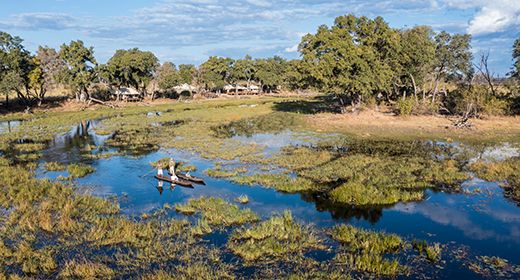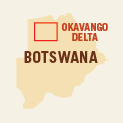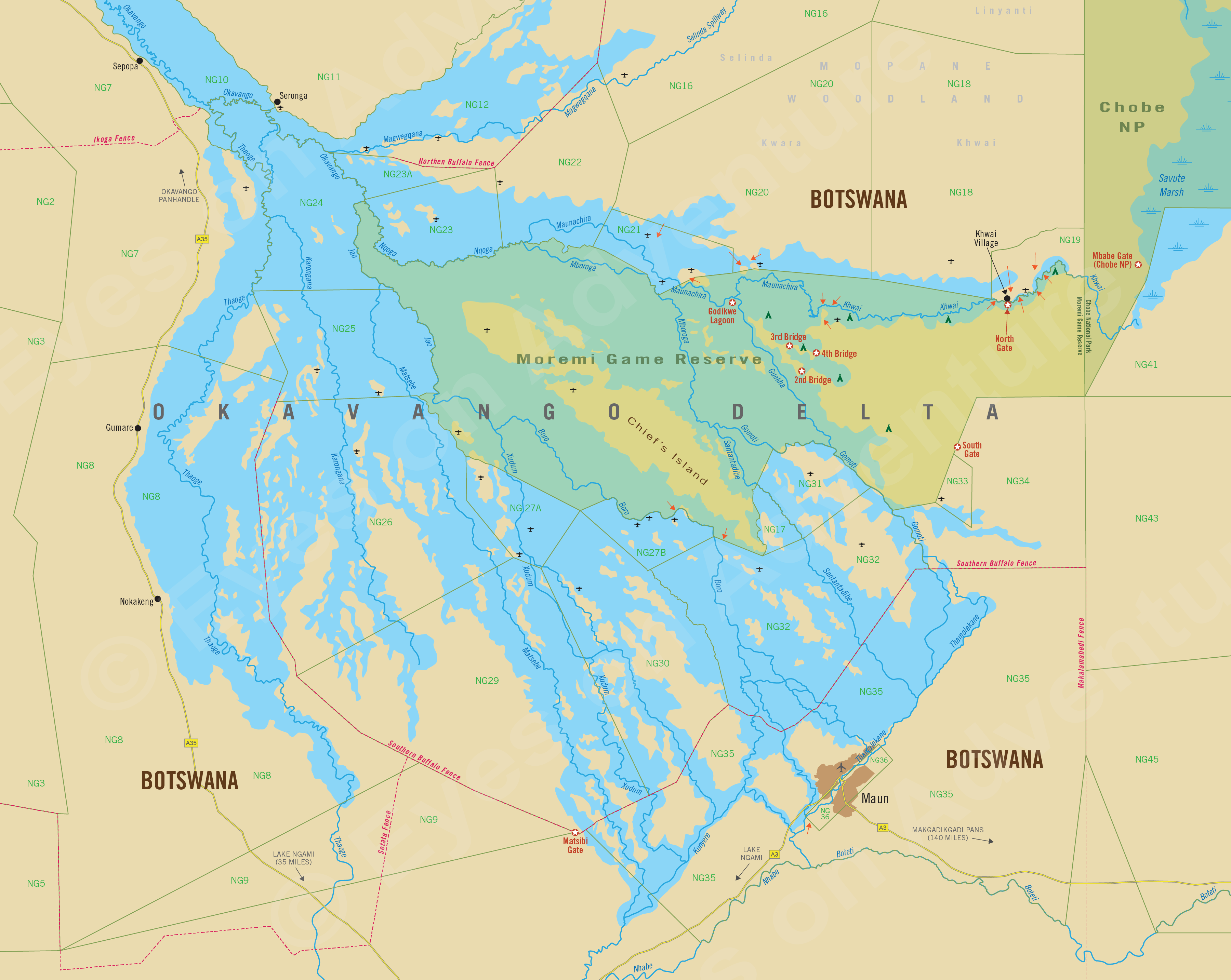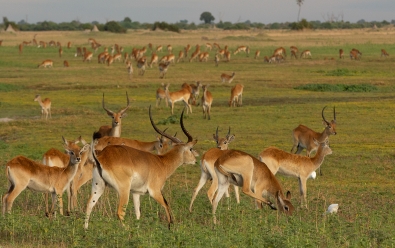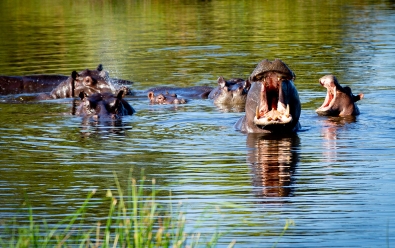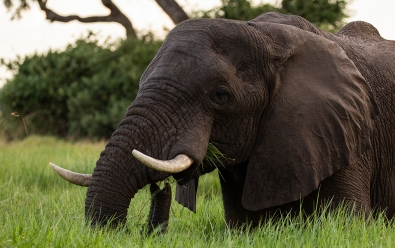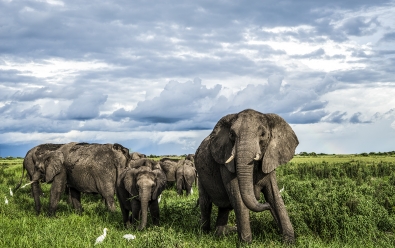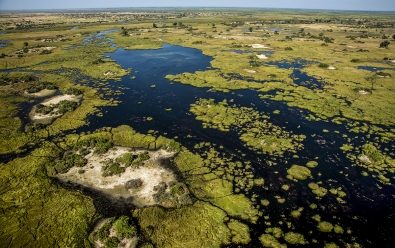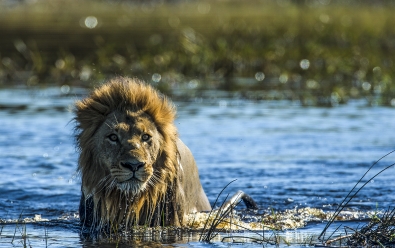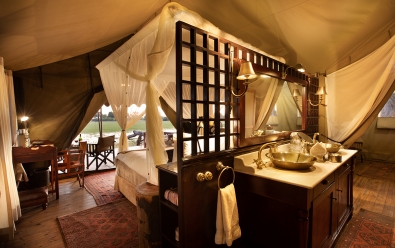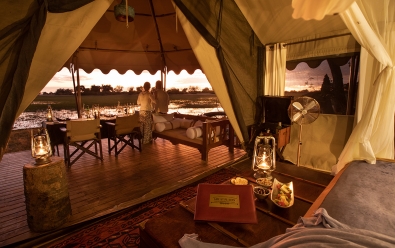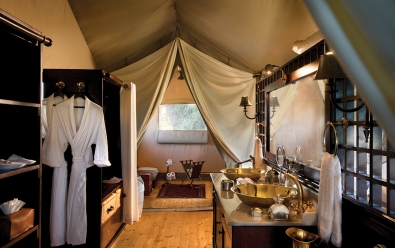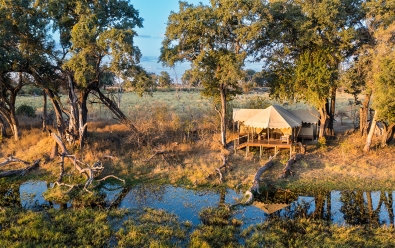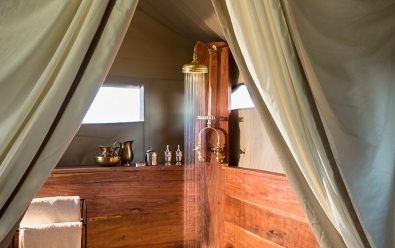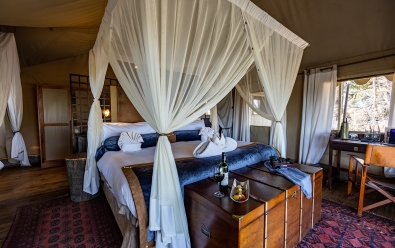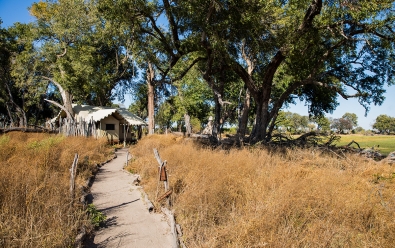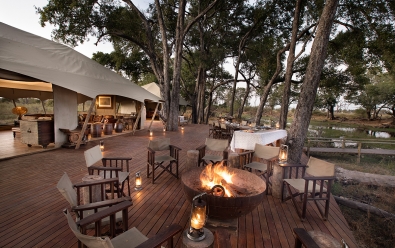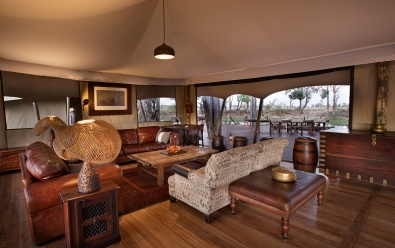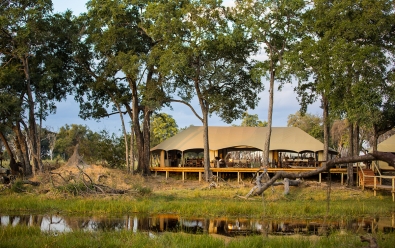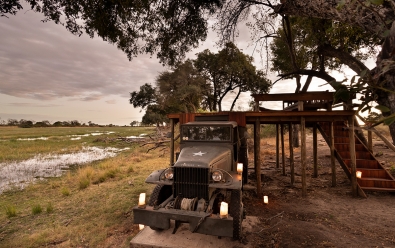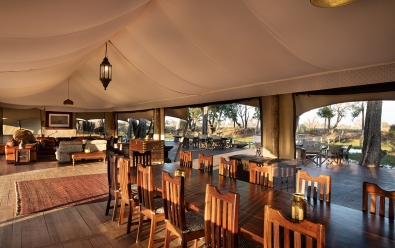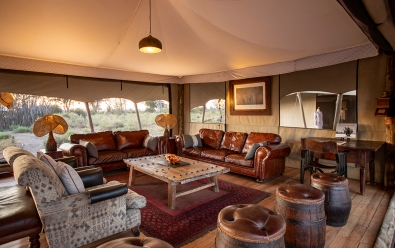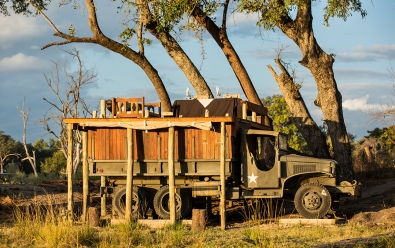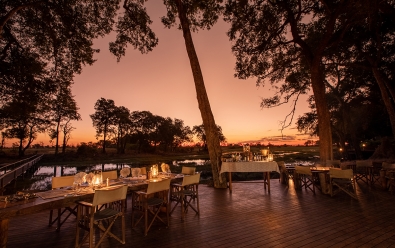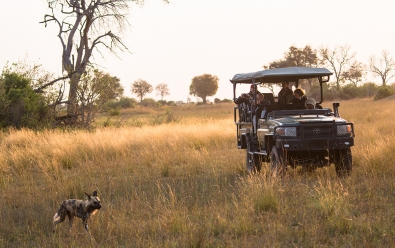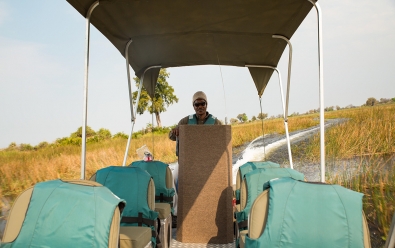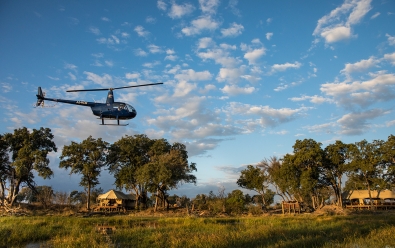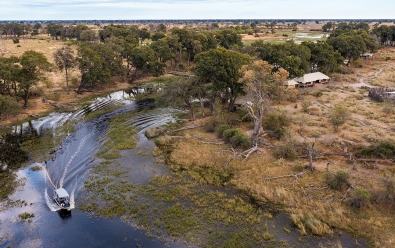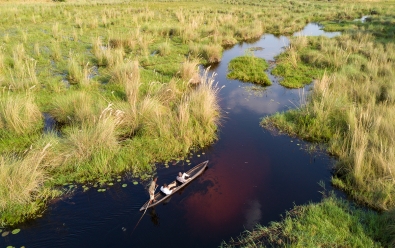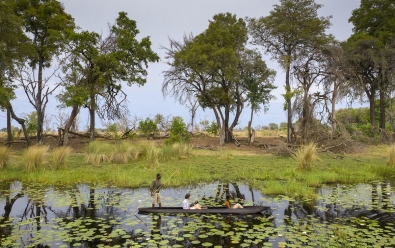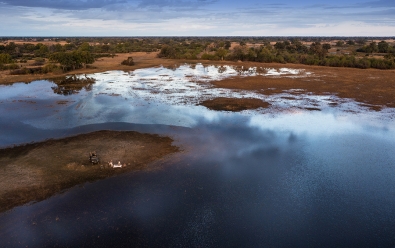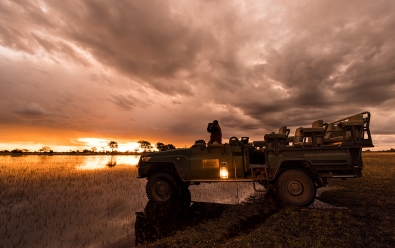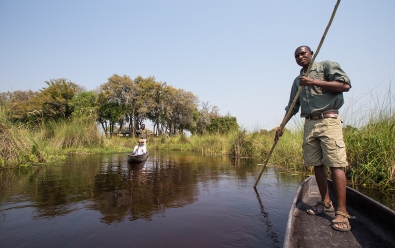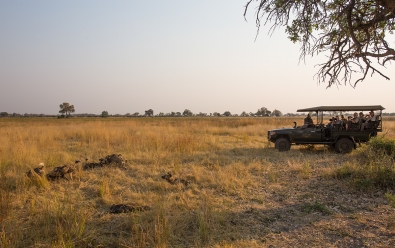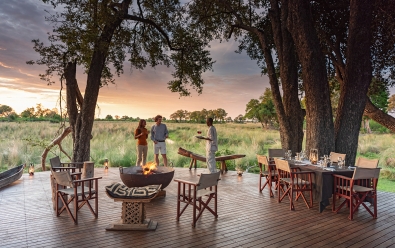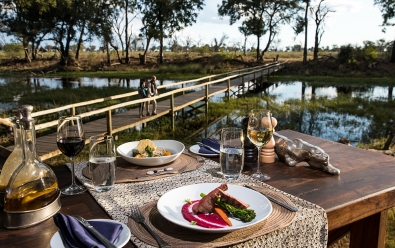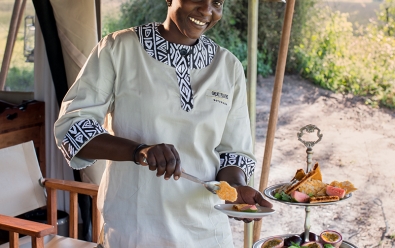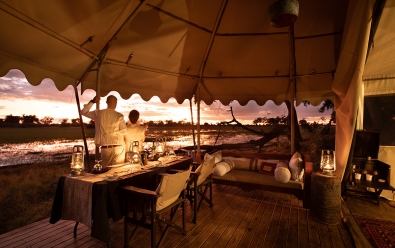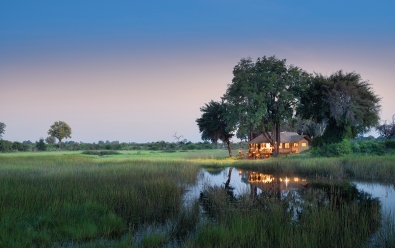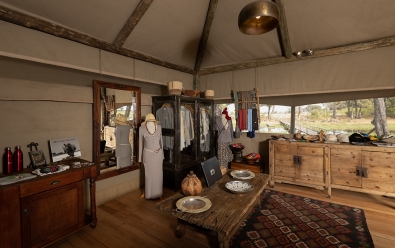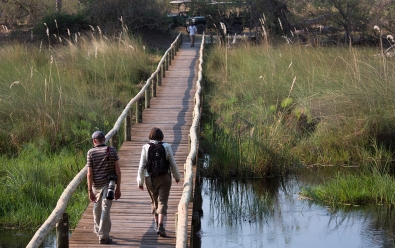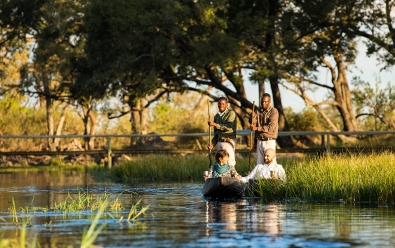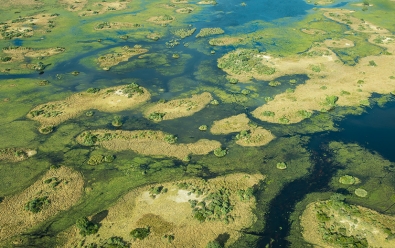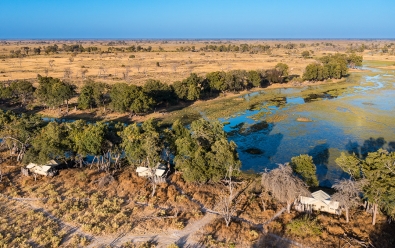Duba Explorers Camp
Highlights
- Remote camp with seasonal floods and permanent channels.
- Superb wildlife destination in a wilderness setting.
- Modeled after a mobile safari camp of the early explorers.
- Game drives, motorized boating, mokoroing, walking, fishing.
Location
- NG23 Private Concession
- Northern Okavango Delta
- Northern Botswana
Duba Explorers is a small camp located in the water-rich northern Okavango and a throwback to the mobile safaris of the region's early explorers, but with modern conveniences and luxuries.
Duba Explorers is one of only two safari camps (the other being Duba Plains Camp) in the 127-square-mile (330-sq-km) Duba Plains Reserve, so guests will enjoy a truly exclusive experience in this water-rich, Okavango Delta wilderness.
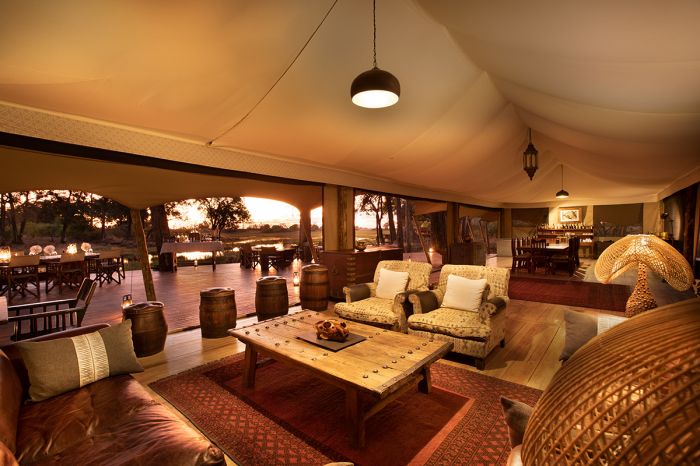
The main guest area at Duba Explorers Camp.
Wildlife viewing in this area of the Okavango is excellent, with large numbers of both predators and herbivores, including lion, leopard, African wild dog, spotted hyena, elephant, buffalo, giraffe, zebra, red lechwe, tsessebe, waterbuck, impala, greater kudu, and more. The deeper channels are home to large numbers of both hippo and crocodile. Bird life is also prolific and diverse.
The camp is situated on a small island and overlooks a semi-permanent channel and floodplain that are rich in wildlife and natural beauty. Setting out from the camp on a mokoro, the traditional canoe used by the indigenous people, is a must for guests at the camp. The rich grasses attract good numbers of grazing wildlife, including elephant, buffalo, and red lechwe.
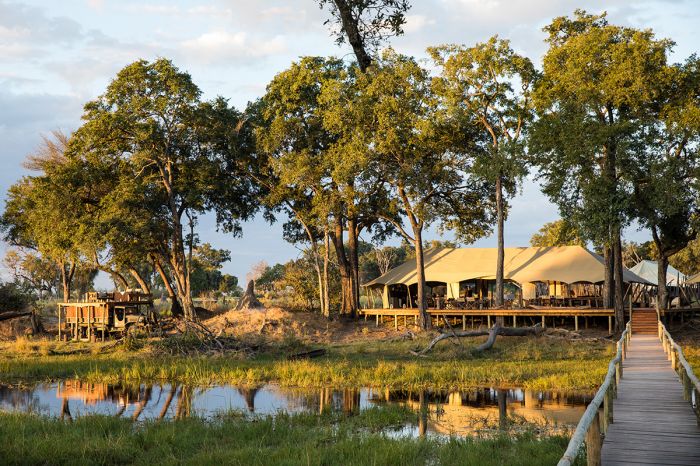
View to the main lounge, dining area, viewing deck, and elevated pool deck (atop the WWII truck) at Duba Explorers Camp.
Duba Explorers Camp is owned and operated by Great Plains Conservation, an organization whose mission is to blend sustainable tourism with the conservation of wildlife environments. Great Plains is headed by the husband-and-wife team of Beverly and Dereck Joubert, who are well known to wildlife enthusiasts for their outstanding films, most of which have been created in conjunction with National Geographic.
Great Plains use the term “Conservation Tourism” to describe what they do. They define it as the use of quality-led tourism experiences that are environmentally sound, with the benefits going specifically into making the conservation of an area viable and sustainable.
The Great Plains model takes stressed and threatened environments, surrounds them with compassionate protection and intelligent, sustainable management, and funds them with sensitive, low-volume, low-impact tourism.
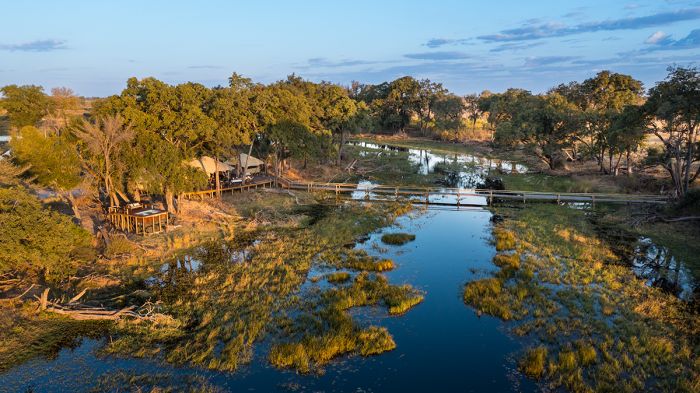
Main guest area showing the foot bridge, main deck and lounge, and unique pool at Duba Explorers Camp.
Activities at Duba Explorers Camp focus on water-based activities, including motorized boating and mekoros, a guided walks with professional, armed guides. Game drives in open-sided 4x4 safari vehicles are offered in the morning and afternoon. Full-day drives (with brunch delivered to the vehicle) are an option, as are short drives after dark to search for nocturnal wildlife activity.
Water-based activities offer a different experience and a safari by mokoro or boat (dependent on water levels) allows for up-close, but safe wildlife encounters, as well as superb birding. Seasonal catch-and-release fishing is also offered. For those wanting to keep active, a guided bush walk is a nice way to see the little things that are often missed on a safari drive.
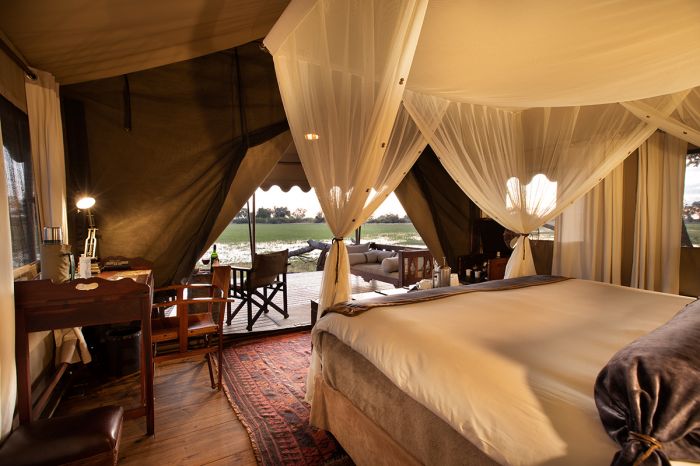
Guest tent interior and view.
Duba Explorers Camp offers only 5 classic, Meru-style safari tents. The tents evoke the romantic and adventurous time of the early European explorers, with campaign-style furniture, Persian rugs, and brass and copper fixtures. The tents include plumbed, en-suite facilities with a hot-and-cold water shower, wash basins, and flush toilet.
The main camp area is constructed beneath a canopy of shady trees and is designed to emulate the mobile safari camps of Africa's early explorers. Two Bedouin-style, open-air tents, one which is a lounge and dining space and the other a safari boutique, form the main guest area. A large viewing deck is also used for dining and relaxing between activities. The authentic classic-safari look and feel of the camp creates a nostalgic atmosphere of elegance, mixed with adventure and relaxation. A unique plunge pool and elevated sundeck offers a cool respite for the midday hours.
Great Plains are one of Africa's leading safari operators and they strive to minimize energy consumption at all their camps. Duba Explorers Camp was constructed using mainly recycled hardwoods and canvas. Most of the camp’s electricity comes from solar energy. Strict eco-friendly environmental standards are maintained so that no harmful chemicals or waste is allowed to enter the pristine ecosystem of the Okavango.
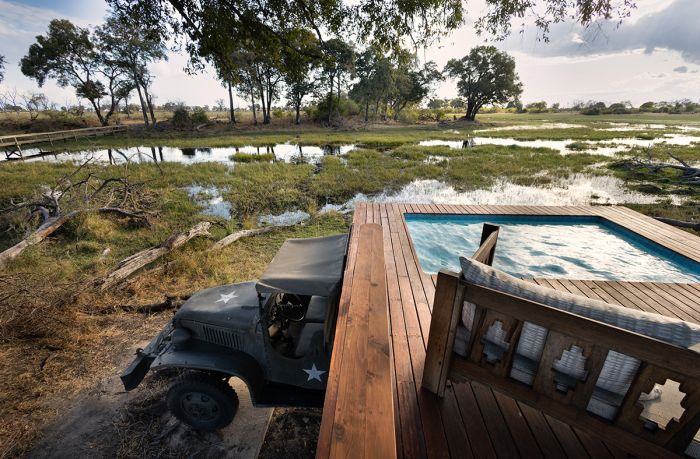
The unique plunge pool and deck at Duba Explorers Camp.
About the Okavango Delta
The Okavango Delta is one of Africa's greatest safari destinations and offers an incredible diversity and abundance of wildlife. The Okavango is an UNESCO World Heritage Site as well as a Ramsar Wetland of International Importance.
Often referred to simply as "the Delta", the Okavango is characterized by an ever-changing network of waterways that originate far to the northwest in the highlands of Angola. The Cubango River flows into northern Botswana and spills into the flat expanse of Kalahari sands, where it fans out into a shallow trough formed by tectonic faults beneath the sand.
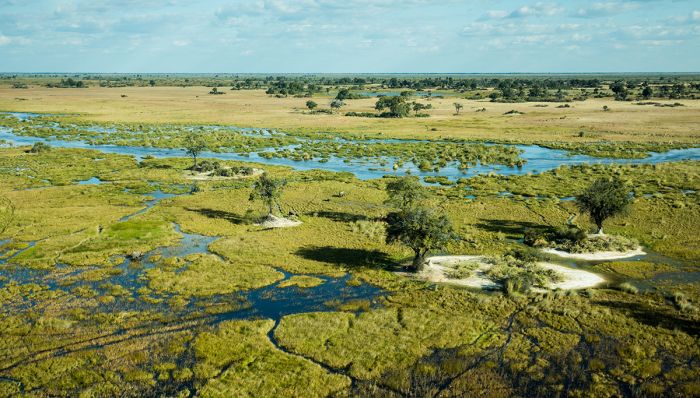
Aerial view of the northern Okavango Delta and the Duba Plains concession.
The annual 'flooding' of the Okavango brings in rich sediments that provide nutrients atop the sands, which in turn creates a diverse ecosystem of permanent and seasonal waterways, deep-water lagoons, papyrus beds, palm-covered islands, seasonally flooded grasslands, and woodlands. The rich fresh-water environment changes year-to-year depending on the level of the floodwaters making it one of the most dynamic wildlife destinations on Earth.
Wildlife in the Okavango Delta is diverse and includes all of Africa's Big Five animals (lion, leopard, elephant, rhino, and buffalo. Commonly seen herbivores include giraffe, plains (Burchell's) zebra, blue wildebeest, impala, tsessebe, common reedbuck, greater kudu, waterbuck, buffalo, elephant, and warthog. Both species of rhino are found, albeit in small numbers. The Delta is also home to red lechwe and sitatunga, both of which are water-dependent antelopes.
The abundance of herbivores means that predators are common in the Okavango. Commonly seen species include lion, leopard, spotted hyena, black-backed jackal, and African wild dog. Cheetah are sometimes seen in the larger grasslands like those on Chief's Island. Less frequently encountered predators include serval, caracal, honey badger, and various species of mongoose.
The abundance of water in the Okavango provides habitat for Nile crocodiles and hippos, both of which are seen easily at any of the safari camps located near the Delta's permanent water. Primates in the Delta include chacma baboon, vervet monkey, and bush baby (galago).
Birding is outstanding in the Delta, with over 400 species possible. A typical safari day can easily produce over 100 species for an avid birder.
ROOMS INCLUDES & EXCLUDES CHILDREN FACILITIES ACTIVITIES
Accommodation
5 guest accommodations in total comprising:
- 5 semi-permanent, Meru-style, canvas safari tents. Double or twin-bedded setup are both available.
Each safari tent includes campaign-style furniture, Persian rugs, and brass and copper fixtures. The fully-plumbed, indoor bathrooms include a shower, flush toilet, and double-basin vanity.
The guest tents are connected to the main camp area by sandy footpaths on the ground.
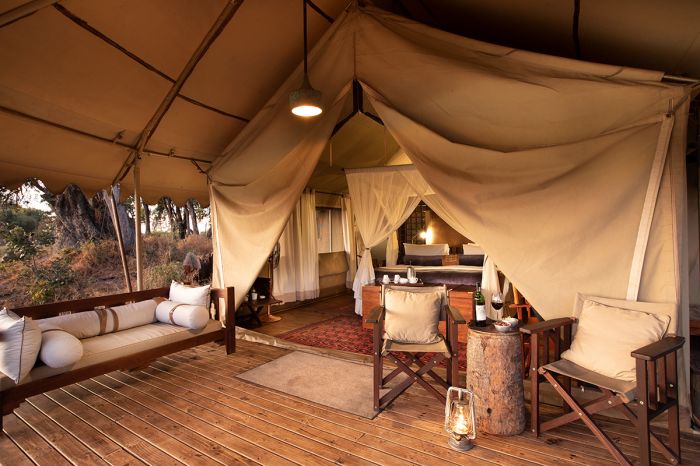
View into a guest tent at Duba Explorers Camp.
The style of the camp and its guest tents evokes adventure and nostalgia, brining one back to stories about the early days of colonial exploration in East Africa.
The tents include specially-crafted furnishings that replicate those used by the early explorers from a bygone era, creating a romantic experience. The interior décor is sourced from Zanzibar and the Far East, with colorful rugs and recycled hardwoods.
The tents are at ground level on slightly-raised, wooden platforms. In front of each tent is a covered veranda with comfortable seating for relaxing while looking out over the floodplain and water channel in front of the camp.
Other items and features in all of the guest units include:
- Writing desk and chair.
- Mosquito netting over the beds.
- Electronic safe.
- Standing fan.
- Tea and coffee station.
- One pair of high-quality, 8x30 binoculars to use during your stay.
- Yoga mats and light weights.
- Limited Wi-Fi in the guest tents.
- The tents have individual solar panels for 24-hour electricity.
- A battery charging station is in the main camp area with international plug sockets including UK, Europe and USA.
- Personal amenities, including soap, shampoo, conditioner, and lotion.
Duba Explorers Camp can accommodate a maximum of 10 guests in total: 2 guests in each of the three standard tents. Additional guests are possible as triples for children sharing with adults can be arranged upon request.
Includes & Excludes
Includes:
- All meals and alcoholic and non-alcoholic beverages, including premium beverages.
- Safari experiences (twice-daily or full-day game drives, drives after dark, bush walks, canoeing and mokoro activities, both subject to water levels, seasonal fishing, and birding) accompanied by an experienced guide.
- Laundry services are provided on a daily basis (weather permitting, items will be returned on the same day). Laundry is dried by the sun and on most days any laundry placed out in the morning will be returned by the evening.
- Return, scheduled, seat-in-plane air transfers from Maun and/or Kasane Airports, as well as inter-camp air transfers from properties in the greater Okavango Delta and Linyanti/Savuti regions to this camp (subject to a minimum 2-night stay).
- Dub airstrip and Vumbura airstrip transfers.
- Duba Explorers Camp traverses the northern Duba Plains concession and is different to the area of the central part of the concession, where Duba Plains Camp is located. Guests at either camp cannot cross by vehicle from one side of the concession to the other due to deep water channels.
- Wi-Fi access.
- Tourism Levy & VAT.
Excludes:
- Purchases from the Great Plains Boutique.
- Scenic helicopter flights ranging in cost based on duration. Best to book in advance.
- Any applicable wildlife fee, park fee, reserve fee, concession fee, other land-use fee.
Single Supplement
A single supplement may apply for any room booked by a single traveler; please ask us for pricing.
Children
Children aged 6 years and older are accommodated at Duba Explorers Camp:
- Triples for children sharing with adults can be arranged upon request.
- Child rates are applicable for one child aged 15 years and younger, sharing with two adults in a tent.
- Children 15 and younger must share a tent with at least one adult.
- Children aged 16 years and older will pay applicable adult rates and be accommodated in a separate tent.
- Families will be combined with other guests on all activities unless a private vehicle is booked at extra cost.
- Children can participate in walking activities from 8 years of age.
- Young children must be supervised by their parents, as the camp is not fenced and is located in an area with high predator densities and there is water surrounding camp.
- The Great Plains Young Explorers program is thoughtfully designed to give children a range of experiences and topics from birding to cooking to art to wildlife tracking.
Facilities
Duba Explorers Camp is situated in the far northeast corner of the Duba Plains concession, an area that includes both permanent and seasonal waterways and floodplains.
The camp is surrounded by a floodplain that holds water for most of the year, so it is only accessible via two, gum-pole foot-bridges. The island is surrounded by beautiful landscapes and water courses.
The main camp area is constructed beneath a canopy of jackalberry (ebony), leadwood, mangosteen, and fig trees and is designed to mimic the mobile safari camps of Africa's early explorers.
The main guest area is under a large, sweeping marquee of canvas, set upon raised decking with an open-concept dining and lounge area. A second, smaller and adjacent tented space houses a boutique shop. Both space open onto a large front deck that is often used as an outdoor dining space.
The authentic classic-safari look and feel of the camp creates a nostalgic atmosphere of elegance, mixed with adventure and relaxation.
Main guest area facilities include:
- Two open-air tented spaces: one that includes a lounge, dining, and bar area and the other that is a safari boutique shop.
- Expansive deck used for dining, relaxing, and watching for wildlife.
- Campfire area with seating.
- A unique, elevated plunge pool and deck that is built into the bed of a World War II truck.
- A bar with a coffee-and-tea station.
- Dining is typically communal, but private dining is available on request.
- All dietary requirements are catered for, from regular to vegan to children; prior notice required.
- Complimentary Wi-Fi access.
- Mobile phone signal unavailable.
- Mineral water is provided in the main camp areas and in the guest tents.
- The camp is run entirely using solar power with generator back-up.
Activities
Duba Explorers Camp focuses primarily on the traditional safari activities of walking, canoeing, and mokoroing. Game drives are also offered.
Activities included in the rate:
- Twice daily (or full-day with picnic lunch) game drives. Drives after dark are also offered. The vehicles are open-sided, canopied, 4x4 vehicles.
- During winter months, hot water bottles (on early morning game drives only), blankets, and lined ponchos are provided.
- Guided walks led by licensed guides with firearm training.
- Birding.
- Mokoro excursions on the myriad waterways around the camp, water-levels dependent.
- Seasonal (between March and December) rod-and-reel fishing on a catch-and-release basis.
Optional activities at additional cost:
- Private activities are on offer (subject to vehicle availability which needs to be booked in advance).
- Scenic helicopter flights ranging in duration from 30, 45 to 60 minutes. The activity is best between 11:00 and 15:00, when animal densities are high. Must be booked in advance.
Example of a typical day:
- Early morning wake-up call. Morning wake-up and activity times vary according to the seasons, activities on offer, and wildlife sightings.
- Light breakfast before departing on the morning activity.
- Return to camp for a meal and rest period.
- Meet for afternoon tea and snacks (savory and sweet choices) before departing on the activity.
- Return to camp - freshen up or meet for drinks, followed by dinner.
- Enjoy a nightcap or discussion around the fire before retiring.
Great Good Fair Poor
- Jan
- Feb
- Mar
- Apr
- May
- Jun
- Jul
- Aug
- Sep
- Oct
- Nov
- Dec
WHEN TO GO
The Okavango Delta offers very good wildlife viewing opportunities all throughout the year, but there are seasonal variations in terms of weather that may be a consideration when planning your visit.
The high season in terms of tourist demand is during the dry months between June and October. The latter part of the rainy season is the low season.
The winter (June through August) is dry and cool and wildlife may be easier to find as rain water is evaporating and the rivers and deeper waterholes become more frequently visited by the animals.
During the middle and later stages of the rainy season, the grass becomes tall and the bush becomes lush and thick, which makes for lovely colors, but makes spotting wildlife more difficult.
Duba Explorers Camp is open year-round.
Summer / Rains
Northern Botswana, including the Okavango Delta receives most of its rain between December thru February, which is the summer season. November and December are wonderful months to visit the Delta, with only occasional rainstorms and most rain coming in short showers, which bring relief to the thirsty land after the dry season.
January and February typically experience afternoon downpours on most days, but all-day rain is very uncommon. By the middle of March, the rains become much less frequent and the grass and bush have grown long and thick. Mornings become cooler by the end of March.
In spite of being summer, the rains keep temperatures from becoming overly hot, although humidity and insect life are at their peak. Days are mostly overcast or partially cloudy, with dramatic skies and a lovely green color to the landscape. Afternoon temperatures average 88°F (31°C), but mornings are very comfortable at around 65°F (19°C).
Baby animals are in abundance, especially impala lambs and warthog piglets. Migratory birds arrive to breed and dramatically increase the number of species and overall numbers, particularly in the lagoons and pans, which are full of rain water and food for the aquatic species.
Unlike the dry months (May through October), when the middays can be very warm, causing wildlife to minimize activity and seek shade from around 10am til mid-afternoon, the overcast skies in the summer often mean that animals are active throughout the day, offering many more hours of game viewing.
Autumn
March, April and May are Fall season months and the beginning of the dry season in the Okavango, with rains very uncommon from around mid-March. The landscape is still lush and green, with sunny days and comfortable temps; afternoons average 84°F (29°C). Mornings are comfortable, but a fleece and base layer may be needed for the first hours on game drive.
Migrant birds fly north and water in the lagoons and rain pans is drying up. Permanent waterways in the Delta are however rising, as the 'flood' water from the Angolan highlands is now reaching the Delta.
Morning temps are around 54°F/12°C and afternoons average 79°F/26°C.
Winter / Dry Season
June through August is winter and the vegetation is drying and going dormant. The Okavango flood water is peaking but the surrounding landscape is mostly brown and yellow. Dust and sand particles in the air is on the rise. Game viewing is superb, with elephant and buffalo herds congregating along permanent water.
Mornings can be chilly to very cold at around 45°F (7°C). Warm clothes, including winter hat and gloves are needed for the open-air game drives. Dress in layers, as the temps do rise quickly during the day, with middays reaching 79°F (26°C).
Spring
September and October are the driest months as the landscape and animals eagerly await the coming rains. Game viewing is phenomenal, with all lagoons and rain pans completely dry and animals congregating around permanent waterways. The flood levels are down and the grass and vegetation mostly dried.
Days are warm, sunny and often cloudless and by mid-morning, most animals are seeking shelter in the shade and awaiting the evening temps to drop. October can be brutally hot and dusty and even smoky as sporadic grass fires can occur.
Safari camps are mostly full to capacity, with guests adhering to guide books saying this is the only tome to visit (not true of course!) Temperatures in October can easily reach 95°F (35°C) or even hotter.




